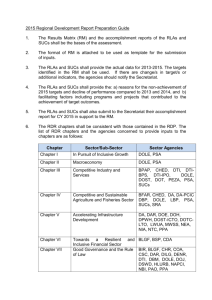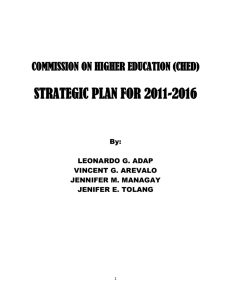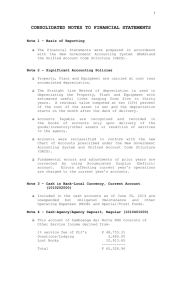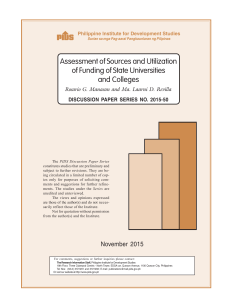University of the Philippines: MOOE Allocation
advertisement
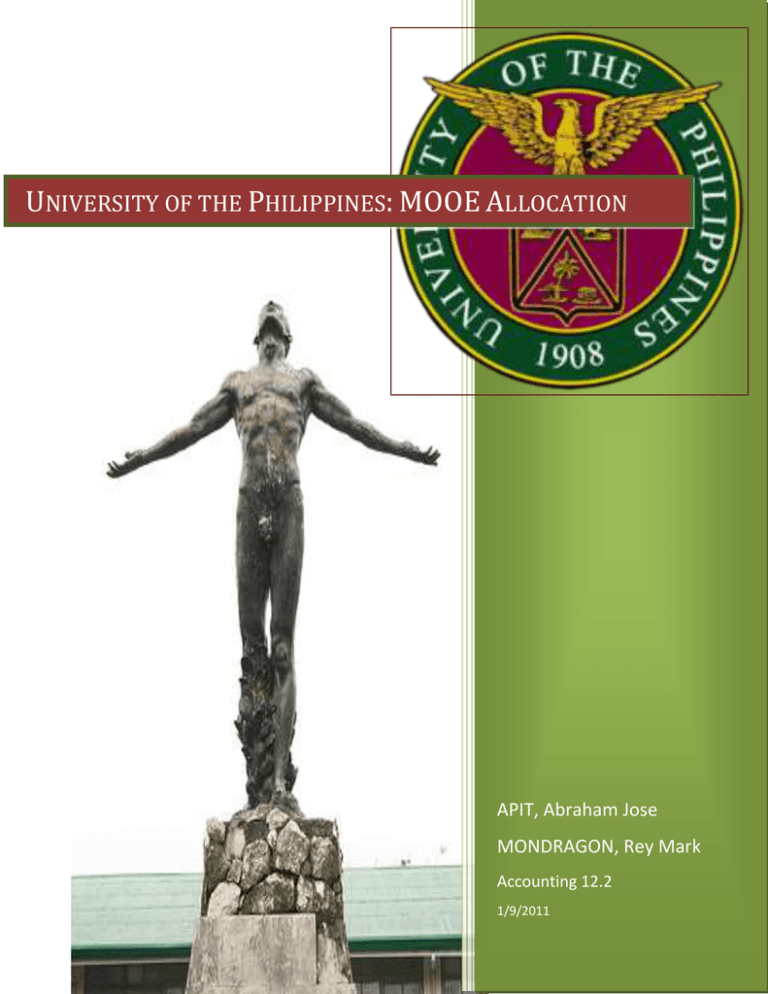
2011 UNIVERSITY OF THE PHILIPPINES: MOOE ALLOCATION APIT, Abraham Jose MONDRAGON, Rey Mark Accounting 12.2 1/9/2011 Table of Contents CHAPTER 1 ............................................................ 3 CASE BRIEF ......................................................... 3 MANAGEMENT’s DILEMMA ............................................... 3 MANAGEMENT’s QUESTION .............................................. 4 RESEARCH QUESTIONS ................................................. 4 CHAPTER 2 ............................................................ 5 INDUSTRY ........................................................... 5 Brief Description: ............................................... 5 Regulating Agencies: ............................................. 5 Nature of Activities: ............................................ 7 Accounting Practices: ............................................ 8 Types of funds: .................................................. 8 Regulatory Constraints: .......................................... 9 NATURE OF THE ENTITY .............................................. 11 CHAPTER 3 ........................................................... 14 References: ......................................................... 22 2|Page CHAPTER 1 CASE BRIEF The newly appointed Vice President for Planning and Finance of the University of the Philippines is faced with the problem of a reduced budget for Maintenance and Other Operating Expenses (MOOE) for the CY 2000. As a first step, she reviewed the previous year’s MOOE allocation and found herself unsatisfied with the way the allocation was done. To address this matter, she then called up a meeting with the unit heads of the different autonomous campuses of UP to discuss the issue on the reduced budget. Different problems and arguments were raised by the said unit heads regarding the previous year’s budget. This was then taken into consideration by the VP for Planning and Finance in coming up with a formula that would objectively allocate MOOE among the campuses. Additional data, considered as important by the VP, were gathered to aid her in the process. MANAGEMENT’s DILEMMA The MOOE budget allocation, as perceived by the Vice President for Planning and Finance is inadequate in responding to the different needs of the constituent universities. This is because the bases for allocation included only few variables (i.e., number of students, presence of laboratory requirements per campus). There are also biases from the congressmen and DBM that were considered in the budget allocation. Some of these biases are political in nature. In addition, the proposed budget of the different universities is subject to the influence of the president’s thrusts. Hence, the heads of the units need to integrate the priorities of the president in their proposed budget. With this, the VP is facing the dilemma of how will she allocate the budget. Will it be following the previous allocation which is inappropriate yet conforms the president’s 3|Page thrusts or make her own allocation basis which she believes is fair but might not get the president’s approval? MANAGEMENT’s QUESTION Considering the dilemma above, how can the management of UP, specifically the VP for Planning and Finance, achieve and implement a more objective process of coming up a MOOE budget allocation formula that is commensurate to the different needs of the constituent universities and that will probably get the president’s approval? RESEARCH QUESTIONS These are the research questions we would like to explore in this case study: a. What is MOOE and the common classifications of expenses included in it? b. What are the most appropriate bases or critical variables to be considered in allocating the appropriated MOOE budget to the entire UP system? c. Is the additional information gathered by the VP for Planning and Finance adequate enough in order to create a budget allocation that is reasonable considering the circumstances at hand? d. Why should a budget allocation made from the information gathered by the VP for Planning and Finance be pursued even if it may not otherwise be totally in accordance with what the president wants? 4|Page CHAPTER 2 INDUSTRY Brief Description: The Philippines is considered to be one of the most highly educated middle-income countries. It has high enrollment rates at all levels of education and it has achieved near universal access to primary education (World Bank website 2008). The first baccalaureate degree granting institution is the University of the Philippines. Regulating Agencies: On May 18, 1994 through RA No. 7722 or the Higher Education Act of 1994 authored by Senator Francisco Tatad, the Commission on Higher Education (CHED) is created. The CHED oversees the higher education system. It is an agency attached to the Office of the President of the Philippines for administrative purposes. CHED is responsible for administering and supervising both public and private higher education institutions in the Philippines. Higher education institutions establish and maintain their own internal organization. The framework of their organization is generally divided into two areas, namely: policy formulation and policy implementation. The formulation and/or approval of all policies, rules and standards in the school is the main function of the Governing Board. The implementation of policies and the management of the school operations are vested in the administration headed by the President. The SUC's autonomy is assured by their individual charters. They are authorized to open curricula and institutional programs, and award their own degrees. However, on July 22, 1997, a landmark legislation was made enacting into law Republic Act 8292 otherwise known as the "Higher Education Modernization Act of 1997." This Act provides among others for the uniform composition and powers of the governing boards of SUCs with the Chairman of CHED as the Chair of the governing boards of all SUCs (previously chaired by the DECS Secretary). With this new set-up, in effect this places all SUCs under the supervision, policy and development mandate of CHED. This enables the CHED to exert influence or provide proper guidance on 5|Page the quality and directions of the academic programs as well as on the internal operations of the SUCs. The private institutions, on the other hand, experience some degree of freedom only when their programs are Level III accredited. This means they are already deregulated and can initiate reforms in their curricular offerings without the need for CHED's approval. Otherwise, private schools have to apply for permit from CHED to open a course, and they have to apply for recognition of their programs in order to be allowed to graduate their students. Recognition of programs is granted if the institutions have fully complied the minimum requirements prescribed by CHED. With regard to awarding of certificate, diploma or degree to students, this is done only if all academic requirements have satisfactorily been completed by the students. After verification of the information, the CHED issues a "Special Order" number which is noted in the student's transcript of records. In the case of CHED-supervised institutions and local universities and colleges, the CHED monitors the implementation of policies, rules and standards. These institutions have to secure authority from CHED if they want to open a course. If their program offerings have the necessary authority from CHED (or DECS previously), their graduates are automatically recognized. Higher Education Institutions: The Philippine Higher Education Institution is categorized into: private and public. Each higher education adopts a certain admission policy beyond the general requirement that all candidates have to be graduates of secondary education. Some institutions require passing an entrance exam and a medical examination; others adopt open admission, but selective retention. Further, Philippines has relied on private institutions and, at the turn of the century, private institutions have increased in numbers. As of August 2010, there are 2,180 HEIs geographically distributed over the country. There are a total of 1,573 and 607 private and public HEIs, respectively. The Public HEIs, on the other hand, include: 110 SUCs main campuses, 388 satellite campuses, 93 LUCs, 10 Other Government Schools, one (1) CHED Supervised Institution (CHEDARMM) and five (5) special HEIs. 6|Page The State Universities and Colleges (SUCs) are chartered public higher education institutions established by law, administered and financially subsidized by the government. SUCs have their own charters. The Board of Regents (BOR) for state universities and a Board of Trustees (BOT) for state colleges maintain the formulation and approval of policies, rules and standards in SUCs. The Chairman of CHED heads these boards. However, CHED Order No. 31 series of 2001 of the Commission en banc, also authorizes CHED Commissioners to head the BOR/ BOT of SUCs. Implementation of policies and management are vested on the president, staff, and support units of the public higher education institutions. The local universities and colleges (LUCs) are those established by the local government through resolutions or ordinances. LUCs are financially supported by the local government concerned. A CHED Supervised Institution (CSI) is non-chartered public post-secondary education institution established by law, administered, supervised and financially supported by government. Other government schools (OGS) are public secondary and post-secondary education institutions, usually technical-vocational education institutions that offer higher education programs. Special HEIs are directly under the government agency stipulated in the law that created them. They provide specialized training in areas such as military science and national defense. Nature of Activities: The activities of an educational institution may be classified as (1) instructional, (2) administrative, and (3) auxiliary. Instructional activities include both resident & extension instructions, public services, organized research, and the operation of libraries. Administrative activities include staffing and promotion, registration and enrolment, operation of business office, and operation and maintenance of the educational plant. Auxiliary activities include the operation of residence halls, dining rooms, college unions and bookstores, health centers, and athletic and cultural programs. Revenues in support of these different activities are provided by such varied sources as contributions, governmental appropriations, student fees, endowment income, and revenues from the sale of goods & services. 7|Page Accounting Practices: Considering these activities of the educational institution, a “modified accrual basis” of accounting is generally employed in summarizing the operations of the state universities and colleges (SUCs). Since the primary purpose of accounting for educational institutions is to report on the stewardship of the funds and property entrusted, rather than to determine the net profits and net worth (American Council of Education). However, privately-owned institutions do not receive any appropriations. Therefore, the accrual method is commonly followed. Depreciations, in addition, are rarely recognized on properties that are used for educational functions by SUCs. However, these are appropriate under following circumstances: a. When certain properties of the educational plant render a service function and the institution plans to replace such properties from operating revenue. b. When properties are identified with auxiliary enterprises that are expected to be self-supporting- bookstores, cafeterias and dormitories, for example. c. When properties are transferred to the educational unit under the terms of endowment that limit expenditures from endowment resources for general and specific purposes to periodic net income after the recognition of appropriation charges for depreciation. Types of funds: SUCs are highly subsidized by the government. Funds are further grouped into: current fund (restricted and unrestricted), loan funds, endowment and other nonexpendable funds, annuity funds, plant funds- which is subdivided into: unexpended plant fund, retirement of indebtedness fund, and an invested in plant section, and agency funds. Current funds are composed of current resources that are to be employed in meeting obligations arising from the general operations of the educational institution, with or without restrictions. Student fees and resources from gifts, for example, that carry no specific limitations as to use, then, are 8|Page reported in the current unrestricted fund. On the other hand, resources from gifts that can be spent only for specified purposes, such as for the library, for scholarship, for an athletic program, or for research, would be classified as current restricted funds. Loan funds consist of resources that are available for loans to student. These funds originate from gifts which may be built up over a period of time from student fees collected for such purpose or from transfers from endowment fund whose income is available for such purpose. However, loan fund balances will change as a result of uncollectible loans, fund administrative expenses and the like. Endowment funds are formed when cash or other properties are transferred to the institution under conditions that provide only the income produced by such resources can be used for the institution. Annuity funds, on the other hand, are formed when cash and other properties are transferred to the institution subject to the requirement that specified payments be made to a designated beneficiary during his lifetime. However, these funds are sometimes included with endowment fund for accounting and reporting purposes. As indicated by its name, plant funds are resources related to educational plant while agency funds are funds given to educational institution which acts as an agent or trustee; holding certain asset on behalf of others, for example, student deposits and tax withholding amount. Regulatory Constraints: Budgetary allocations and allotment received by SUCs depend on the budget proposals made by the Department of Budget and Management (DBM) which is duly approved by the Congress. It is then believed that some legislators want to allocate more funds in the region that support their candidacy. As of this year, SUCs will experience drastic cuts in their budget if the Congress approves the Aquino government’s 2011 budget proposal. In the budget proposal submitted by the Department of Budget and Management (DBM) to Congress last August 25, the combined budget for 110 SUCs is cut by 1.7% from P23.8 billion 9|Page in 2010 to only P23.4 billion this year. Among those with the biggest budget cuts are University of the Philippines (-P1.39 billion or 20.11%), Philippine Normal University (-P91.35 million or 23.59%), Bicol University (P88.81 million or 18.82%), University of Southeastern Philippines (-P44.39 million or 20.03%), Central Bicol State University of Agriculture (-P31.65 million or 15.91%). Huge cuts are proposed in the budget for maintenance and other operating expenses (MOOE) of all but 15 SUCs, some by more than 50%. The combined total operations budget for SUCs will be cut by P1.1 billion, or by 28.16%. Budget distribution: The DBM has devised a scheme to check fund allocations for each school through a system called “normative clemency.” This is based on the three major types of government expenditures: capital outlays which deal with financing building construction; personal services, which cover faculty salaries; and maintenance and other operating expenditures, which cover electricity, water, telephone, and janitorial services. Normative clemency ensures that no SUC will have an excess or lack of funds for all three types of expenses, because they are mandated to submit proposed expenses to both the Commission on Higher Education (CHED) and the DBM. Tax Exemption: Per section 30 of National Internal Revenue Code of the Philippine, income from government educational institutions are duly exempted from income tax. 10 | P a g e NATURE OF THE ENTITY The University of the Philippines is the national university of the country. It was established on June 18, 1908, an act of the First Philippine Legislature. Act No. 1870, otherwise known as the "University Act", specified the function of the University, which is to provide advanced instruction in literature, philosophy, the sciences, and arts, and to give professional and technical training. At present, the University of the Philippines System is composed of seven constituent universities (CU) located in 12 campuses around the country. These are UP Diliman, UP Los Banos, UP Manila, UP Visayas, UP Mindanao, UP Open University, and UP Baguio. UP Diliman is the flagship campus of the university and offers the most number of courses. Each constituent university of UP is headed by a chancellor, who is elected on a three-year term by the Board of Regents. The governance of the University is vested in the Board of Regents of the University of the Philippines System. The board, with its 12 members, is the highest decision-making body of the U.P. system. The Chairperson of the Commission on Higher Education (CHED) serves as the Board's acting Chairperson while the President of the University of the Philippines is the CoChairperson. The Chairpersons of the Committees of Higher Education of the Senate and the House of Representatives are members of the UP Board of Regents which are concurrent with their functions as committee chairpersons. The University offers 246 undergraduate degree programs and 362 graduate degree programs, more than any other university in the country. The flagship campus in Diliman offers the largest number of degree programs, and other campuses are known for specific programs. The University has 57 degree-granting units throughout the system, which may be a College, School or Institute that offers an undergraduate or a graduate program. 11 | P a g e At present, the university has a total student population of 53,285; 4,135 faculty, trained locally and abroad with 75% having graduate degrees; administrative staff and personnel of 6,491; and 3,553 PGH staff. The University is one of the three Universities in the Philippines affiliated with the ASEAN University Network, and the only Philippine university to be affiliated with the ASEANEuropean University Network and the Association of Pacific Rim Universities. The University has the highest financial endowment of all educational institutions in the Philippines. In 2008, the entire University system has a financial subsidy from the national government of about PHP 6 billion. The total expenditure for the same year, however, is PHP 7.2 billion, or approximately PHP 135,000 per student. This estimated PHP 1.2 billion difference is supported by other funds. These include general fund, revolving fund, trust fund- student fees, and central fund. Central funds can be tapped for the non-recurring expenses, for instance, supplementary miscellaneous expenses. Central funds comprise of general maintenance funds, faculty development funds, staff development funds equipment fund, and reprogrammed or programmed funds for PS, MOOE, or CO. Trust fund, in addition, covers the laboratory fees, educational development fees, library fees, athletic fees, cultural fees, and medical fees paid by the students. Admission, however, into the University's undergraduate programs is very competitive, with over 60,000 students taking the exam every year, with about 11,000 being accepted, an admission rate of about 18%. Admission to a program is usually based on the result of the UPCAT (UP College Admission Test), and University Predicted Grade, which is an average of grades obtained during high school and sometimes, a quota set by the unit offering the program. As it is funded partly by the Philippine government, and private donations, the UP student shoulders a minimal tuition 12 | P a g e fee which is appropriately less than half than that of other universities like the Ateneo de Manila, La Salle University and the University of Santo Tomas, while providing a wider range of courses and programs. At present, the estimated annual tuition fee of UP is PhP 36,000 good for two terms at PhP 1,000 per unit. The Socialized Tuition and Financial Assistance Program (STFAP) was implemented in response to the increase in tuition in 1989. The program, proposed in 1988 by U.P. President Jose Abueva and mandated by the President and Congress of the Philippines, called for a radical departure from the old fee and scholarship structure of UP, resulting in tremendous benefits for low-income and disadvantaged Filipino students. The STFAP is divided into four basic components: Subsidized Education, Socialized Tuition, Scholarships and Student Assistantships. Through the Socialized Tuition and Financial Assistance Program (STFAP), more popularly known as Iskolar ng Bayan, students avail of discounted tuition fees to full tuition fee waivers, plus cash subsidies, according to their individual income brackets. Most colleges in the UP System offer scholarship opportunities in different programs — from the arts to the sciences. Some of the scholarships available throughout the UP System are the Oblation scholarship for the top fifty (50) passers of the UPCAT, the UP Government Scholarship, the Presidential Scholarship Grant, the Leadership Grant and various private grants, all administered through the Office of Scholarships and Student Services (OSSS). 13 | P a g e CHAPTER 3 1. What is MOOE and the common classifications of expenses included in it? Maintenance and Other Operating Expenses (MOOE) is one of the general classifications of expenses in the operation of a government institution. Other classifications include the Personal Services, Capital Outlays and Financial Expenses. MOOE includes expenses necessary for the regular operations of a government agency like, among others, traveling expenses, training and seminar expenses, water, electricity, supplies expense, maintenance of property, plant and equipment, and other maintenance and operating expenses. The Chart of Accounts of the New Government Accounting System of the Philippines lists the following expense line items as composing the MOOE: a. Traveling Expenses b. Training and Scholarship Expenses c. Supplies and Materials Expenses d. Utility Expenses e. Communication Expenses f. Professional Services g. Repairs and Maintenance h. Subsidies and Donations i. Confidential, Intelligence, Extraordinary and Miscellaneous Expenses j. Taxes, Insurance Premiums and other Fees k. Non-Cash Expenses (Bad debts, Depreciation, etc.) l. Other Maintenance and Operating Activities 14 | P a g e 2. What are the most appropriate bases or critical variables to be considered in allocating the appropriated MOOE budget to the entire UP system? Budget preparation is one of the difficult and timeconsuming, yet also one of the indispensable and beneficial, activities that an organization’s management performs in line with its vision, mission and goals. An organization can benefit from creating a budget that shows how it plans to use its resources and to make sure that its spending doesn’t get out of control. By carefully planning how the organization spends and saves its resources, it shall have a better chance of reaching its goals. As ruled, allocations of funds for expenditures to SUCs shall be based on Normative Funding, as detailed in a joint circular dated 2004 authored by the heads of DBM and CHED. This Normative Funding shall serve as a tool for planning, preparing, implementing and checking the budgeting process of an SUC. In the UP budget process, the VP for Planning and Finance has the following responsibilities: a. Reviews the consolidated budget prepared by the UP’s Budget Office in the early phases of budget preparation. This budget is to be submitted to DBM for review and revisions in the preparation of the General Appropriations Act(GAA); b. After the submitted budget is approved by the Congress and the President of the Philippines, the VP reviews the budget ceilings prepared by the Budget Office. The budget ceilings are prepared for the UPSA units and the autonomous campuses and shall be used in the preparation of the Internal Operating Budgets (IOB) for said units/campuses; c. Helps in the preparation of IOB and reviews it before requesting the university president to recommend the IOB to the Board of Regents (BOR). 15 | P a g e The MOOE appropriated is generally subdivided into two parts: MOOE for academic programs and the UP system administration (UPSA); and MOOE for autonomous campuses. In the case presented, the allocation is on the ratio of 66:34 for the UPSA and for the campuses, respectively. Meanwhile, it is shifted into 62:38 in the following year. The analysis is presented in the table that follows. Maintenance and Other Operating Expenses (MOOE) Budget * CY 1999 Ratio** CY 2000 Ratio Academic programs & UPSA 602,124, 000 66% 403, 561, 000 62% Autonomous campuses 313, 801, 000 34% 250, 000, 000 38% TOTAL 915, 925, 000 100% 653, 561, 000 100% *Budgets are based on the figures presented in the case. **Ratios are rounded-off to nearest whole number. The VP for Finance and Planning should have allocated the MOOE on the same ratio as of the previous year for the following reasons: a. Any cut in the MOOE budget must be applied across the board on a pro-rata basis using the previous allocation. It is quite unfair that academic programs & UPSA will suffer a 33% decrease compared to the 20% decrease on autonomous campuses; and, b. Considering the thrust of higher authorities which is, UP being a premiere university, should be promoting graduate programs. Thus, any cut-back will impair the programs. A 4% variance in the budget allocation, roughly 26 million, will greatly affect the performances of academic programs. However, it will be reasonable also to make the allocation on a ratio of 62:38 considering also the demand of the autonomous campuses. Different UP campuses offer different programs and perform the trifocal function of SUCs, that is, instruction, research and extension services in varying degrees. 16 | P a g e Now, the task of the VP for Planning and Finance is the preparation of a reasonable budget allocation of MOOE to UP’s constituent universities considering the budget cut. Critical variables for budgeting should be properly taken into consideration in order for the VP to achieve this goal. To start, the VP may base this year’s budget on the previous year’s actual expenses. Then, s/he may analyze the cost drivers for MOOE for Instruction, MOOE for Research and MOOE for Extension services by asking appropriate officers. These cost drivers should be used in the allocation and should be as detailed as possible in order to have a greater probability of meeting actual expenditures. For example, the number of buildings used to compute repairs may be broken down into number of classrooms and adjusted for the age of such properties. To be taken into analysis also is the varying degrees of activities and achievements in the three functions of the university. Priority allocation may be given to campuses whose performance on a certain area might be greatly affected if allocated a budget materially different from what it proposes right from the start. For example, a campus suffers a decrease in its licensure examination passing rate because of a reduced budget for instruction. This is to ensure that the expenditure funds go to where they are most worthy for. After creating a preliminary budget based on these data, adjustments may be made based on the campus’ ability to generate income or cash flows out of its available funds. For example, a campus is doing well in research activities and surely needs funds for it to maintain or improve this status. It may still be allocated funds way below its proposed budget if it generates surplus funds from other sources. These surplus funds may serve as a complement to the appropriated budget. 17 | P a g e 3. Is the additional information gathered by the VP for Planning and Finance adequate enough in order to create a budget allocation that is reasonable considering the circumstances at hand? The additional data gathered by the VP as extracted from the case include the following: a. Number of students per campus based on predetermined weights; b. Number of students with laboratory subjects; c. Number of Faculty and Research and Extension Personnel Staff (REPS); d. Number of Faculty, REPS, and Administrative Personnel; e. Number of Buildings; f. Number of Campuses. For us, these data is helpful but not adequate enough to address the problem on formulating a reasonable budget. In order to have an objective and reasonable budget, all data that would be gathered by the VP from the suggested activities mentioned in the earlier discussion (answer to number 2) should be integrated in the drafting of the budget. The cost drivers or bases used in allocating budget to MOOE for Instruction may be different from the ones to be used for Research or Extension Services. Or it may use the same drivers if reasonable, but the level of activity associated should be considered. For example, student activity is expected to be higher in Instruction than in Extension. In MOOE for Instruction for example, the common applicable drivers that could be used may include all of the data listed in a to f but certain adjustments may be made such as the following: a. The weights reflected in the number of students are based only on the level of education of a student. Weights to reflect the respective courses of tertiary students 18 | P a g e should also be reflected because some courses are costly than the other in terms of MOOE; b. Excluding the Research and REPS from the analysis because these data is most appropriate for MOOE for Research and Extension; c. Detailing the number of buildings as to how many are used only for instruction; d. Detailing the classified buildings as to number of classrooms. The above adjustments may be applied in the same logic to MOOE for Research and for Extension. It should be noted that the data presented are applicable only in making the preliminary cost budgets. Adjustments to reflect a campus’ liquidity and profitability advantages could not be made using only these data. Hence, the VP may gather the following data from the previous school year to address this problem: a. Statement of Operations of the individual campuses in order to assess their profitability; b. Statement of Cash Flows in order to have an idea of the different sources of cash inflows and outflows and as well as the magnitude of these cash flows; c. Statement of Financial Position for the computation of liquidity and other financial ratios that may be used in the analysis. 4. Why should a budget allocation made from the information gathered by the VP for Planning and Finance be pursued even if it may not otherwise be totally in accordance with what the president wants? A budget allocation that would be made using the discussed procedures should be pursued because of the following reasons: 19 | P a g e a. Budgeting based on detailed data is beneficial because there’s a greater chance of meeting anticipated costs. Take note that the budget would be used in calculating tuition fees and other fees of the students. If the budgets prepared are based on inappropriate drivers, the resulting calculations for fees of students might be much higher or lower, or fees of students in one campus might be much higher or lower when compared to other campuses and may prove inequitable. The problem on budget cuts for SUCs is still around in today’s times. It is reflected in the recently approved 2011 national budget. The reduced budget for SUCs elicits varied comments from the people (specially the students) noting that increases instead for debt servicing, military spending and ‘corruption funds’ (pork barrel, dole-out and patronage funds) were pursued. We think that this way of budgeting would help carry on one of the important roles of the State as stated in Article 14, Section 1, of the Philippine Constitution, which says that “The State shall protect and promote the right of all citizens to quality education at all levels and shall take appropriate steps to make such education accessible to all.” When equitable fees are charged by the University and other SUCs, there’s a better chance for Filipinos to avail of higher education and earn a degree considering that private schools are a lot more expensive. This would further help them land a job and improve the economic status of the country. As observed, the effects are spilled over positively. b. The budgeting would, in effect, allow cost-sharing among the campuses. Since the constituent universities have the same mandates and are under the same system, it is but justifiable for them to undertake such kind of strategy. This helps maximize the use of idle excess funds of other campuses. But this does not mean that the less productive campus would exploit the financial wellness of the other. The System should also devise a scheme of giving job 20 | P a g e credits to the heads of a unit who performs well in terms of income generation so that they would be inspired to continue their ways. On the other hand, the heads of the unit who performs subpar from expected should be monitored. They should also be inspired to undertake revenuegenerating activities if these are feasible considering the available funds under their control. The effects of these strategies would likely result to the formation of a management who always strives for the best and not just settle for mediocrity. c. If fees are equitable and when budgets allocated to campuses are commensurate with what they need, then the University’s status as a premier university would likely be improved because of the following: - Satisfaction of students, hence, more and more students will likely be inspired to enroll - Higher rates of graduates because of affordable fees - Catalyst for curbing unemployment rate of the country because UP graduates will likely easily find a job - Satisfaction of managers, hence, they will likely work with enthusiasm and thus would result to reaching organizational goals - An overall improvement in the financial status of the UP System 21 | P a g e References: http://www.upd.edu.ph/~ovca/budgethome.htm http://officialweb.upm.edu.ph/studentsupport.php http://www.thepoc.net/blogwatch-features/10441-faq-aquinosbudget-cut-on-sucs.html http://www.mb.com.ph/articles/289779/abad-seeks-understandingbudget-cut-sucs http://www.senate.gov.ph/press_release/2010/1214_angara2.asp 1987 Constitution of the Philippines www.dbm.gov.ph/GAA2010/SUCS/SUCS_Provision.pdf http://www.rihed.seameo.org/index.php?option=com_content&task=vi ew&id=34&Itemid=41 http://colleges.indiaedu.com/asia/philippines/higheducation.html National Internal Revenue Code of the Philippines www.up.edu.ph/pdf2/senate_resolution_51.pdf www.thepoc.net/.../9585-aquino-slashes-budget-of-state-schools-in2011-proposal.html Punzalan, A. Cardona, M. Government Accounting System, revised 2009 edition. Manila, Philippines: GIC Enterprise & Co, Inc., 2009 22 | P a g e
